Under Fire
Directed by: Roger Spottiswoode
Written by: Clayton Frohman
Starring: Ed Harris, Gene Hackman, Joanna Cassidy, Nick Nolte
USA
AVAILABLE ON BLU-RAY: 17th June, from EUREKA ENTERTAINMENT
RUNNING TIME: 128 mins
REVIEWED BY: Dr Lenera, Official HCF Critic
1979: African rebels win their civil war, so news photographer Russell Price, top correspondent Alex Grazier and ace reporter Claire, with whom Grazier has just broken up with, set off for their next hot spot assignment – Nicaragua, where corrupt dictator Anastasio Somoza seems to be losing his country to the Sandinista rebellion. Russell and Claire can’t wait to begin risking their lives to record what’s going on, but they also get rather close, and Russell’s obsession with finding the elusive rebel leader Rafael begins to alter his allegiance….
There’s a scene in Under Fire where a major character is shot. Rather than going for the expected close-up or dramatic editing with maybe some dramatic music to boot, the act is just shown from a distance, through the eyes of the person watching it, and getting through to us how casual the act is for the people committing it, how commonplace it is for this particular environment. The scene usefully reminds us that violence can often hit harder if handled with restraint. Under Fire is an early entry in that mini-cycle of movies featuring journalists covering war that also included the likes of The Killing Fields, The Year Of Living Dangerously and Salvador. Released during the American government’s heydey of meddling in South and Central American affairs over fears of the Soviet Union [“the evil empire”, as Ronald Reagan called it], Under Fire, my first ever viewing of which was yesterday, struck me as being very similar to Salvador which was made four years later and which seems to have overshadowed it. The two make for an interesting comparison. They both share the same viewpoint, but Oliver Stone’s film is more stylish and technically impressive than Roger Spottiswoode’s, though the latter, despite probably having a lower budget, feels more realistic and seems to probe the ethics of journalism more deeply. It’s also hampered by a love triangle that seems half hearted, as if screenwriters Ron Shelton and Clayton Frohman felt that they had to incorporate it for commercial reasons but weren’t really interested in it at all – though most excellent performances from the three main stars just about make up for this.
Clayton Frohman wrote the original script for this. He was inspired by several true events, most notably the murder of ABC reporter Bill Stewart and his translator Juan Espinoza by National Guard forces on June 20, 1979. ABC cameraman Jack Clark was shooting “incidental” footage at the time, and caught the entire episode on tape. The footage was shown on national television in the United States and became a major international incident, undermining what remained of dictator Somoza’s support. His regime fell a month later and Somoza resigned and fled to Paraguay, where he was later assassinated by Sandanista hit men. Spottiswoode got Ron Shelton to do a rewrite, then Jonathan B. Taplin agreed to produce the film after only two days, which is incredibly fast, as long as Spottiswoode stuck to the budget he proposed. They almost didn’t get Nick Nolte because he only sometimes read scripts, but sending him 50 copies of this one and having them placed on top of his piles of scripts did the job. Filming took place at Chiapas and Oaxaca in Mexico, where they hired 200 real soldiers. The film was never expected to make money, but Lion’s Gate Films were happy to make un-commercial projects that they believed were good films which they would then write off.
We begin in some unnamed African country as the peace of the savannah is interrupted by troops marching along, who are themselves interrupted by a helicopter attacking them while Price photographs the action, the screen going into freeze frames, and one of these pictures winds up on the cover of ‘Time’ magazine. On the back of a truck, Russell encounters Oates, a mercenary he obviously runs into from time to time. Oates suggests that Nicaragua should be the next place for him go to, and along with Russell are his usual companions Alex and Claire, though after a while Alex has had enough and accepts a job as an anchorman back home. By now Price and Claire have already become lovers after just two days [though an early scene shows that the interest has been there for a very long time], something which is probably also a factor in Grazier leaving even though they’d recently split up. Russell seems to virtually ‘inherit’ Claire because they share a preference for fieldwork, but frankly I didn’t feel that I was being made to care much about this – in fact I didn’t even believe that Alex, who’s clearly more interested in his career at the expense of everyone else, loves Claire at all despite what the script tells us. But at least Joanna Cassidy [usually in TV roles, and best known for her Blade Runner role] is an engaging, tough, no-nonsense heroine out of the Howard Hawks school, and both Nick Nolte and Gene Hackman are at the top of their game. I often wonder why Nolte never quite became a huge star, and here he shows again how detailed yet restrained an actor he is while the camera clearly loves him. More here than in any other film, he has more than the touch of Robert Mitchum about him – which in my book is very high praise indeed.
Russell and Claire waste no time in going to war zones, and Russell seems especially seems quite mad as he continually puts himself in danger to get the best shots. This film really rammed home to me the incredible bravery and also the near insanity of people like Russell who just want to show people the truth. However, what he believed was the truth about the situation turns out to be rather different. He probably expected the place to be full of unsavoury characters out to exploit the situation, notably slimy politician/spy Marcel Jazy, and surely he can’t have totally believed everything that President Somoza [there’s a great scene where Claire dresses down and tries to probe him but he just says the same things he says to all interviewees] said was true. I don’t think that Russell is particularly naive, in fact the more I think about it he’s just balanced in his outlook and able to tow the line of the corporate-owned mainstream press, which if you think about it is probably best for a person in his job. But when he starts hanging out with the rebels in an effort to locate their leader Rafael, he begins to sympathise with them more and more, even when he’s asked to do something that’s totally against his very being and which risks putting his fellow journalists in more danger by actively taking sides: to fake a photograph. It’s this faking that seems to rally the Sandinistas just when things seem to have slumped for them a bit, and the Americans become loath to supply more arms when it appears that they’re now on the losing side. I don’t think it’s being a full-blown ‘leftie’ [you could say that I lean that way but without rocking the boat] to say how Under Fire does a great job in drawing attention to the nature and breadth of the foreign support upon which many corrupt and cruel dictatorships relied – and which still rely. This is not propaganda, it’s fact, plain and simple.
The many scenes of Russell and sometimes Claire in the middle of urban conflict seem incredibly vivid, really making one feel what it could be like to constantly be in danger of bullets whizzing past, or being seen. At one point a tank seems like it’s the most frightening thing in the world. Spottiswoode, who was once on the verge of becoming a major filmmaker with this, Air America and Tomorrow Never Dies but since then has adopted a lower profile either through choice or necessity, refuses to try to heighten the action by stylistic means, and shows that all this shaking of the camera and rapid fire editing that many modern filmmakers think provides extra realism isn’t always necessary. Quite often he’ll hold on to a shot for longer than you’d expect, but the edge is not diminished. Despite what I might have made it sound like, Under Fire adopts a surprisingly leisurely pace for much of its length, perhaps too leisurely for some though we do get a pretty thrill-packed final half an hour. And there’s some nicely sardonic, yet pointed, dialogue to enjoy, such as: “I work for everybody”, “That’s a great job”. Outside of Nolte, Cassidy and Gene Hackman who’s actually off-screen for quite a lot, the star performance [perhaps unsurprisingly] comes from Ed Harris as the totally amoral Oates who’s even happy to gun down unarmed civilians for profit. Oates rather conveniently shows up when the script requires him to, and some might find him cartoonish, but others may not. In an environment such as this, people like Oates can flourish and I’m sure many do. Minor characters tend to be introduced and then killed soon after, but that’s provides some realism too. The terrible horror of war is certainly present, even if graphic bloodshed is kept to a minimum.
John Alcott ’s cinematography makes often beautiful use of natural light, while Jerry Goldsmith provides one of his best music scores of the period, incorporating the pan pipe and the acoustic guitar plus Spanish-tinged harmonies into the orchestra with electronica sound and style he was developing at the time. Some may find it a bit too upbeat, but then there are moments of elevation in this movie even though it may not sound like it. Though perhaps not quite as penetrating as it could have been on the many issues it deals with, Under Fire does sometimes seem to get to the heart of what makes journalists tick, without resorting to a scene where somebody spells it out verbally, which is probably what the film would do if made today. I think that, all in all, I still prefer Salvador, largely because I found the James Woods character in that and his journey more interesting. But Under Fire is no slouch at all and probably deserves to be much better known than it seems to be.
Rating: 









Under Fire comes to Region ‘A’ Blu-ray in a version probably based on the Region ‘A’ Twilight Time release. Though Eureka have no doubt done a new encode, it looks like a fairly oldish scan, but don’t that put you off – it’s still very sharp and grain is evenly managed. The colour tends to veer to the ever so slightly ‘sickly’ in places, it’s not a major issue but you’ll see what I mean – though flesh tones are generally fine. Good though not great.
Eureka sadly don’t seem able to import the isolated scores that Twilight Time tend to include, but the other three special features are present. The first audio commentary has Twilight Time’s Nick Redman joined by Spottiswoode, assistant editor Paul Seydor and photo-journalist Matthew Naythons who was in Nicaragua at the time of the events depicted. It’s a very laid back track but never less than interesting. Spottiswoode gives us plenty of great stories, like how one of the soldier extras had a live bullet which could have resulted in the death of one of the film’s stars if a last minute check hadn’t taken place, and how the stunt crew backed out of filming without any explanation when they hired the elephants. It was soon discovered that one particular elephant was infamous for demolishing trucks! And Naythons discusses his own real-life scary experiences and even goes into the psychology of people in his job. Seydor is less present but does go into the editing side of things, while Redman keeps things moving along, asking the right questions at the right time, though surprisingly given his interest in film music doesn’t go into the score very much. A really fine track though.
Well I spoke too soon about the music, because the second audio commentary featuring music mixer-producer Bruce Botnick, music editor Kenny Hal and film historians Jeff Bond, Julie Kirgo, and Nick Redman again is more devoted to that, though it sometimes dovetails into things like the film’s reception [apparently Spottiswoode though it would be a big hit], and the nature of mixing a score, and spends much of the second half talking about Goldsmith, and not just his music. You get a good impression of him and hear some good stories, mostly from other films though a row over the Under Fire score mix is discussed. Sadly the original score tracks [the re-recorded album is quite different] seem to be lost. Kirgo doesn’t say much, and I think this track will obviously appeal far more to score lovers than anybody else, but I was engrossed enough until towards the end. Also ported over is Joanna Cassidy Remembers Under Fire, though it’s very short, its three minutes mostly devoted to her praising the film.
Take out the love triangle or punch it up a bit, and Under Fire would have been great. It still has enough qualities, and the commentaries are interesting enough, for me to say that Eureka’s Blu-ray of the film comes Recommended.
SPECIAL FEATURES
*Stunning 1080p presentation on Blu-ray
*Uncompressed LPCM 2.0 audio
*Optional English SDH subtitles
*Audio Commentary with director Roger Spottiswoode, Assistant Editor Paul Seydor and Photo-Journalist Matthew Naythons, and Film Historian Nick Redman
*Audio Commentary with Music Mixer-Producer Bruce Botnick, Music Editor Kenny Hal and Film Historians Jeff Bond, Julie Kirgo, and Nick Redman
*Joanna Cassidy Remembers Under Fire [3 mins]
*Original Theatrical Trailer
*Limited Edition Collector’s booklet featuring new writing by author Scott Harrison [2000 copies]

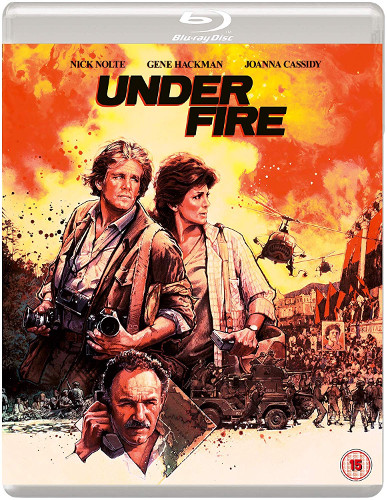
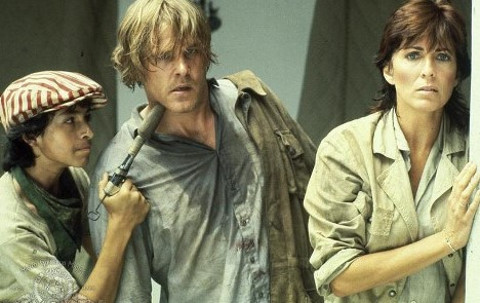
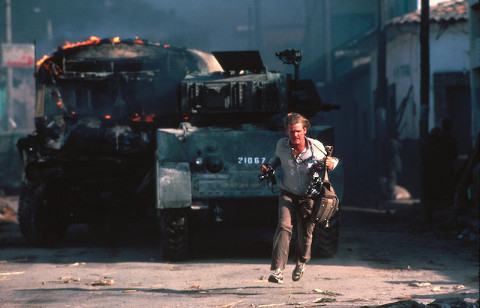

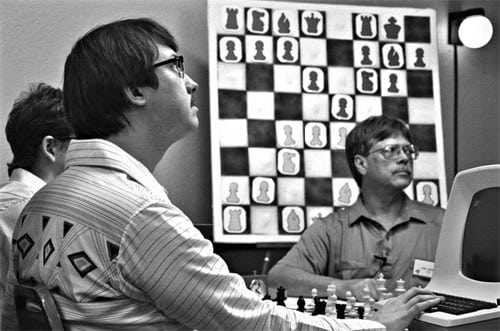
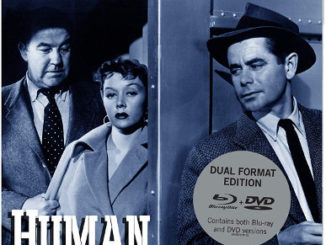

Be the first to comment